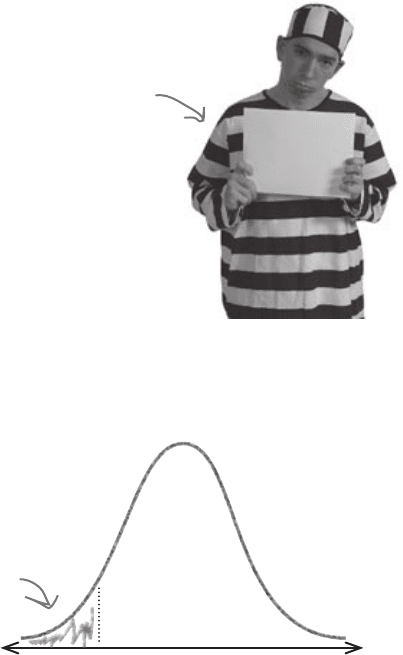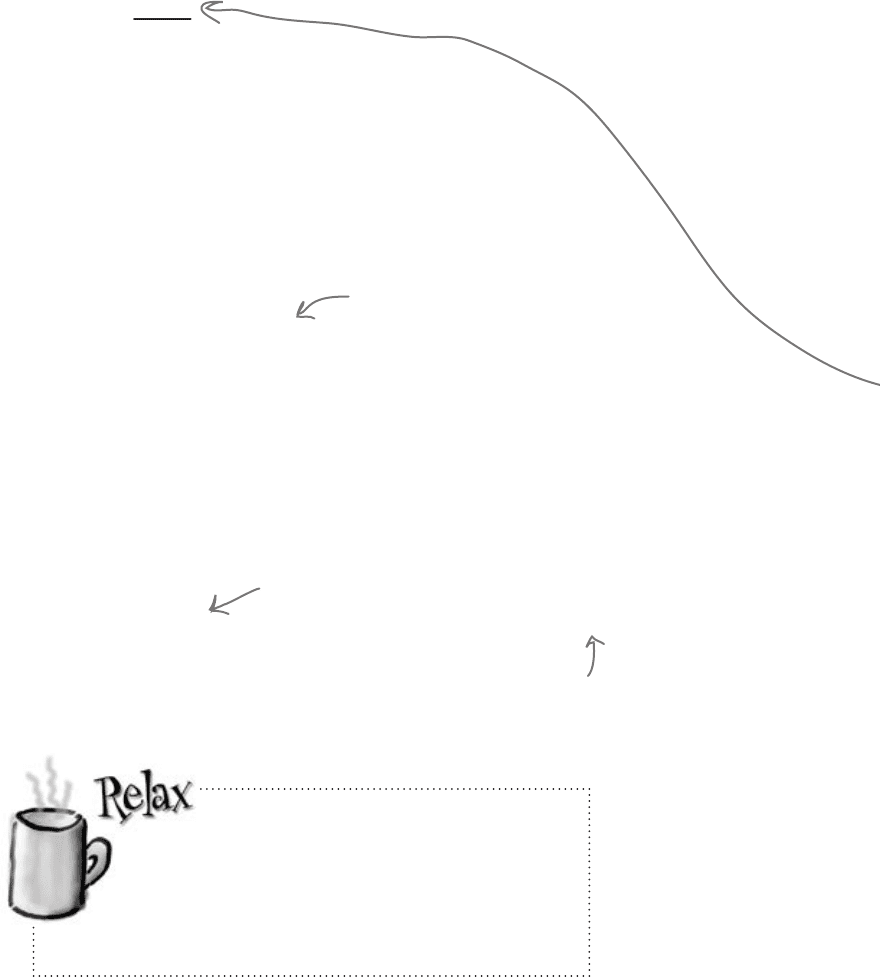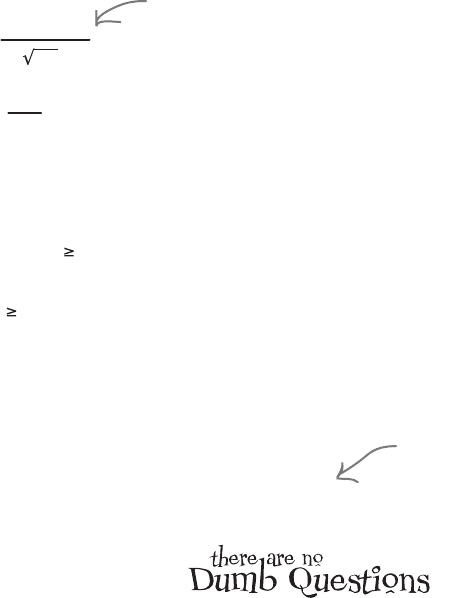Griffiths D. Head First Statistics
Подождите немного. Документ загружается.


you are here 4 551
using hypothesis tests
S
nore
C
ull
S
nore
C
ull
48 T
ableTS
SnoreCull failed the test
This time when we performed a hypothesis test on SnoreCull,
there was sufficient evidence to reject the null hypothesis.
In other words, we can reject the claims made by the drug
company.
Busted...
Hypothesis tests require evidence.
With a hypothesis test, you accept a claim and then put it on trial. You
only reject it if there’s enough evidence against it. This means that the
tests are impartial, as you only make a decision based on whether or
not there’s sufficient evidence.
If we had just accepted the doctor’s opinion in the first place, we
wouldn’t have properly considered the evidence. We would have
made a decision without considering whether the results could have
been explained away by mere coincidence. As it is, we have enough
evidence to show that the results of the sample are extreme enough
to justify rejecting the null hypothesis. The results are statistically
significant, as they’re unlikely to have happened by chance.
So does this guarantee that the claims of the drug company
are wrong?
Shouldn’t we have
just accepted the doctor’s
opinion in the first place?

552 Chapter 13
Of course it is. We’ve
done a hypothesis test, and
we’ve used it to prove that
the drug company is lying.
Mistakes can happen
So far we’ve looked at how we can use the results of a sample as evidence in
a hypothesis test. If the evidence is sufficiently strong, then we can use it to
justify rejecting the null hypothesis.
We’ve found that there is strong evidence that the claims of the drug
company are wrong, but is this guaranteed?
Even though the evidence is strong, we can’t absolutely
guarantee that the drug company claims are wrong.
Even though it’s unlikely, we could still have made the wrong decision. We can
examine evidence with a hypothesis, and we can specify how certain we want
to be before rejecting the null hypothesis, but it doesn’t prove with absolute
certainty that our decision is right.
The question is, how do we know?
Conducting a hypothesis test is a bit like putting a prisoner on trial in front
of a jury. The jury assumes that the prisoner is innocent unless there is strong
evidence against him, but even considering the evidence, it’s still possible for
the jury to make wrong decisions. Have a go at the exercise on the next page,
and you’ll see how.
Q:
How can we make the wrong decision if we’re conducting
a hypothesis test? Don’t we do a hypothesis test to make sure
we don’t?
A: When you conduct a hypothesis test, you can only make a
decision based on the evidence that you have. Your evidence is
based on sample data, so if the sample is biased, you may make the
wrong decision based on biased data.
Q:
I’ve heard of something called significance tests. What are
they?
A: Some people call hypothesis tests significance tests. This is
because you test at a certain level of significance.
our hypothesis might still be wrong

you are here 4 553
using hypothesis tests
A prisoner is on trial for a crime, and you’re on the jury. The jury’s
task is to assume the prisoner is innocent, but if there’s enough
evidence against him, they need to convict him.
1. In the trial, what’s the null hypothesis?
2. What’s the alternate hypothesis?
3. In what ways can the jury make a verdict that’s correct?
4. In what ways can the jury make a verdict that’s incorrect?

554 Chapter 13
A prisoner is on trial for a crime, and you’re on the jury. The jury’s
task is to assume the prisoner is innocent, but if there’s enough
evidence against him, they need to convict him.
1. In the trial, what’s the null hypothesis?
2. What’s the alternate hypothesis?
3. In what ways can the jury make a verdict that’s correct?
4. In what ways can the jury make a verdict that’s incorrect?
The null hypothesis is that the prisoner is innocent, as that is what we have to
assume until there’s proof otherwise.
The alternate hypothesis is that the prisoner is guilty. In other words, if there’s sufficient proof
that the prisoner is not innocent, then we’ll accept that he’s guilty and convict him.
We can make a correct verdict if:
The pr
isoner is innocent, and we find him innocent.
The prisoner is guilty, and we find him guilty.
We can make an incorrect verdict if
The pr
isoner is innocent, and we find him guilty.
The prisoner is guilty, and we find him innocent.
sharpen solution

you are here 4 555
using hypothesis tests
The errors we can make when conducting a hypothesis
test are the same sort of errors we could make when
putting a prisoner on trial.
Hypothesis tests are basically tests where you take a claim and put it on trial
by assessing the evidence against it. If there’s sufficient evidence against it,
you reject it, but if there’s insufficient evidence against it, you accept it.
You may correctly accept or reject the null hypothesis, but even considering
the evidence, it’s also possible to make an error. You may reject a valid null
hypothesis, or you might accept it when it’s actually false.
Statisticians have special names for these types of errors. A Type I error is
when you wrongly reject a true null hypothesis, and a Type II error is when
you wrongly accept a false null hypothesis.
The power of a hypothesis test is the probability that that you will correctly
reject a false null hypothesis.
So what does
putting prisoners on
trial have to do with
hypothesis testing?
Accept H
0
Reject H
0
H
0
True
Type I error
H
0
False
Type II error
Decision from hypothesis test
Actual
situation
This gives you the
power of your test.
These are both
types of errors
How do you think we can find the probability of making a Type I error? How do
you think we can find the probability of making a Type II error?

556 Chapter 13
Let’s start with Type I errors
A Type I error is what you get when you reject the null hypothesis when
the null hypothesis is actually correct. It’s like putting a prisoner on trial
and finding him guilty when he’s actually innocent.
But I’m
innocent
A Type I error is when you reject
H
0
when actually it’s correct.
So what’s the probability of
getting a Type I error?
If you get a Type I error, then this means that
the null hypothesis must have been rejected.
In order for the null hypothesis to have been
rejected, the results of your sample must be in
the critical region.
The probability of getting a Type I error is the probability of your
results being in the critical region. As the critical region is defined by the
significance level of the test, this means that if the significance level of
your test is α, the probability of getting a Type I error must be also be α.
In other words,
If you get a Type I error,
your test statistic must be
here in the critical region.
P(Type I error) = α
where α is the significance level of the test.
type i and type ii errors

you are here 4 557
using hypothesis tests
What about Type II errors?
A Type II error is what you get when you accept the null hypothesis,
and the null hypothesis is actually wrong. It’s like putting a prisoner on
trial and finding him innocent when he’s actually guilty.
Got away
with it
A Type II error is when you accept
H
0
when actually it’s wrong.
The probability of getting a Type II error is normally represented by
the Greek letter β.
P(Type II error) = β
So how do we find β?
Finding the probability of a Type II error is more difficult than finding
the probability of getting a Type I error. Here are the steps that are
involved, and we’ll show you how to go through them on the next page.
Check that you have a specific value for H
1
.
Without this, you can’t calculate the probability of getting a Type II error.
11
Find the range of values outside the critical region of your test.
If your test statistic has been standardized, the range of values must be de-standardized.
22
Find the probability of getting this range of values, assuming H
1
is true.
In other words, we find the probability of getting the range of values outside the critical
region, but this time, using the test statistic described by H
1
rather than H
0
.
33

558 Chapter 13
Finding errors for SnoreCull
Let’s see if we can find the probability of getting Type I and Type II errors for
the SnoreCull hypothesis test. As a reminder, our standardized test statistic is
Z = X - 90
3
where X is the number of people cured in the sample. The significance level of
the test is 5%.
Let’s start with the Type I error
A Type I error is what you get when you reject the null hypothesis when
actually it’s true. The probability of getting this sort of error is the same as the
significance level of the test, so this means that
P(Type I error) = 0.05
So what about the Type II error?
A Type II error is what you get when you accept the null hypothesis when the
alternate hypothesis is true. We can only calculate this if H
1
specifies a single
specific value, so let’s use an alternate hypothesis of p = 0.8, as this is the
proportion of successes in the doctor’s sample. This means that our hypotheses
become
H
0
: p = 0.9
H
1
: p = 0.8
The reason why H
1
must specify an exact value for p is so that we can calculate
probabilities using it. If we used an alternate hypothesis of p < 0.9, we wouldn’t
be able to use it to calculate the probability of getting a Type II error.
If you need to calculate the
probability of getting a Type II error
in an exam, you’ll be given H
1
.
This means that you won’t have to decide on the
alternate hypothesis yourself. If you need to calculate
this sort of error, it will be given to you.
This time we’ll use H
1
: p = 0.8 instead of H
1
: p < 0.8. We can only
calculate the probability of getting a Type II error if we have a
single specific value for the alternate hypothesis.
This gives you the probability of rejecting
the null hypothesis that 90% of people are
cured when it’s true.
calculating type i and type ii errors
To look up probabilities using the
alternate hypothesis probability
distribution, we need an exact
value for p.

you are here 4 559
using hypothesis tests
These values are inside
the critical region.
Z ~ N(0, 1)
We need to find the range of values
Now that the alternate hypothesis H
1
gives a specific value for p, we can move
on to the next step. We need to find the values of X that lie outside the critical
region of the hypothesis test.
We saw back on page 548 that the critical region for the test is given by Z
< -1.64—in other words, P(Z < -1.64) = 0.05. This means that values that fall
outside the critical region are given by Z ≥ -1.64.
Values here are outside
the critical region.
If we de-standardize this, we get
X - 90 ≥ -1.64
3
X - 90 ≥ -1.64 x 3
X ≥ -4.92 + 90
X ≥ 85.08
In other words, we would have accepted the null hypothesis if 85.08 people
or more had been cured by SnoreCull.
The final thing we need to do is work out P(X ≥ 85.08), assuming that H
1
is true. That way, we’ll be able to work out the probability of accepting the
null hypothesis when actually H
1
is true instead. As we’re using the normal
distribution to approximate X, we need to use a probability distribution
X ~ N(np, npq), where n = 100 and p = 0.8. This gives us
X ~ N(80, 16)
This means that if we can calculate P(X ≥ 85.08) where X ~ N(80, 16), we’ll
have found the probability of getting a Type II error.
We calculate this in the same way we calculate other normal distribution
probabilities, by finding the standard score and then looking up the value in
standard normal probability tables.
-1.64

560 Chapter 13
This is the usual way of calculating the
standard score; just subtract the expectation,
and divide by the standard deviation.
P(Type II error) = 0.102
Q:
Why is it so much harder to find P(Type II error) than
P(Type I error)?
A: It’s because of the way they’re defined. A Type I error is what
you get when you wrongly reject the null hypothesis. The probability
of getting this sort of error is the same as α, the significance level of
the test.
A Type II error is the error you get when you accept the null
hypothesis when actually the alternate hypothesis is true. To find the
probability of getting this sort of error, you need to start by finding
the range of values in your sample that would mean you accept the
null hypothesis. Once you’ve found these values, you then have to
calculate the probability of getting them assuming that H
1
is true.
Q:
Do I need to use the normal distribution every time I want
to find the probability of getting a Type II error?
A: The probability distribution you use all depends on your test
statistic. In this case, our test statistic followed a normal distribution,
so that’s the distribution we used to find P(Type II error). If our test
statistic had followed, say, a Poisson distribution, we would have
used a Poisson distribution instead.
This gives you the probability of accepting
the null hypothesis that 90% of people are
cured when actually 80% of people are.
more on type ii errors
Find P(Type II error)
We can find the probability of getting a Type II error by calculating
P(X ≥ 85.08) where X ~ N(80, 16). Let’s start off by finding the standard
score of 85.08.
z = 85.08 - 80
16
= 5.08
4
= 1.27
This means that in order to find P(X ≥ 85.08), we need to use standard
probability tables to find P(Z 1.27).
P(Z 1.27) = 1 - P(Z < 1.27)
= 1 - 0.8980
= 0.102
In other words,
